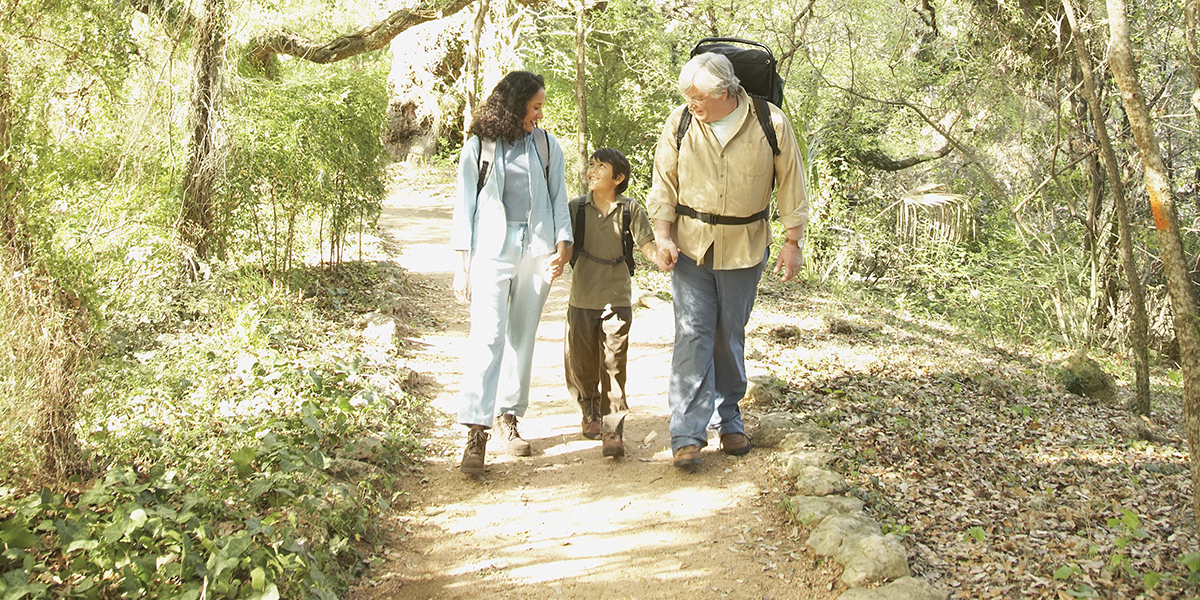Hiking and walking are a great form of exercise—whether you’re just embarking on improving your exercise routine or want to mix in something new. Hiking can burn 400-700 calories per hour and is easier on the joints than running.
“If you have been inactive for some time you may need to check with your primary care physician to make sure that you are safe to initiate an exercise regimen,” says Dr. Donald Hohman, a joint replacement specialist on the medical staff at Texas Health Center for Diagnostics and Surgery.
Hohman also suggests that if you are considering hiking and walking as a first step to reaching a fitness goal, you should start slowly and work up to more difficult trails and longer distances.
“As an example, if your intention is to start hiking, you should start by walking on level surfaces first and then progressing to walking uphill prior to initiating rigorous hiking trails for safety purposes,” he says.
Also take care to make sure you have addressed your feet.
“Proper footwear is certainly important when walking or hiking,” Hohman says. “Comfortable shoes that will provide you with the appropriate padding and support for walking are certainly important to avoid injury. Supportive shoes, primarily around the ankle, are most important when considering safety for hiking. Boots may even be required depending on the trails you may be negotiating.”
This preparation can extend to what you bring with you, too. In addition to having the right footwear, make sure your skin is protected with sunscreen and a good insect repellent, and consider layering your clothing. Research the trail you think you want to hit to make sure you don’t need to dress appropriately for things like snake encounters, high grasses, and other things that might require long pants and socks.
“Make sure that you have your cell phone with you, plenty of water, maybe even some food depending on how long you will plan on being out on the trails,” Hohman says, adding that if you’re entertaining the idea of a longer hike, you should take time before that date to condition your body so you can be safe and have fun.
And your allergies don’t have to stop you from hitting a trail, either. Dr. Steven Peskind, an ear, nose and throat specialist with Texas Health Center for Diagnostics & Surgery, says that your preparations can be as close as your local drugstore shelf.
“Taking medications such as nasal steroids and antihistamines will help before the activity,” Peskind says. “Doing nasal saline irrigations before and after outdoors activities will help a lot, too.”
But if you find yourself really miserable, Dr. Peskind says to seek medical attention if your acute symptoms don’t respond to nasal steroids or antihistamines. Consideration of longer term management with testing for environmental allergens and allergy immunotherapy might be appropriate.
Hiking can also help the mind. A recent study revealed that the exercise you get from walking can help with memory, and reduce stress and anxiety. Another study in the Proceedings of the National Academy of Sciences found that “nature experience may improve mental well-being.”
So whether you’re a novice or an expert, hitting the trails is a low-cost, heart-healthy activity, and there are many benefits to walking, Hohman says.
“The heart-healthy benefits of physical activity can be achieved through activities such as walking,” he says. “What matters most is how frequently and for how long you are able to participate in these activities. If you can safely walk for 30 minutes a day that is an excellent first step in maintaining a healthy lifestyle.”
May 06, 2019
'Take a Hike!' For Your Well Being
Did you know that hiking can burn 400-700 calories per hour and is easier on the joints than running? Here's how to get started safely.
Categories: Dr. Hohman Medicine News
Share This Post:
